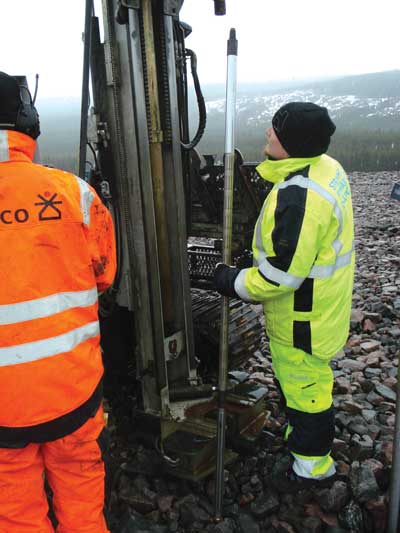 |
| A crew carries out dam rehabilitation drilling with a Wassara water-powered rig. |
LKAB Wassara, the Swedish company that develops and manufactures unique water-powered drill systems for surface and underground operations, noted that there are more than 48,000 dams in the world that have a structural height above foundation of 15 m or more. Most have water seepage problems to some extent, raising the questions of: how many are leaking to a point where rehabilitation is required, and what’s the best way to do it?
A common method to rehabilitate a dam is to create a seal—a concrete wall or a grout curtain, for example—usually accomplished by drilling boreholes up to 100 m or more deep, then injecting grout into the holes to seal any cavities. This can be done either during construction or later. Older dams may undergo rehabilitation several times.
An absolute requirement for drilling equipment used to rehabilitate dams is the capability to not cause harm or distress to any structure being penetrated. Factors such as minimal borehole deviation or avoidance of pressurizing rock formations are crucial—pressurization of the formation can lead to damage in adjacent structures as well. The two most common drilling technologies that meet these demands are percussive drilling with a water-powered DTH hammer, and rotary drilling.
Wassara said the U.S. Army Corps of Engineers performed a comparison test of its water-powered DTH hammer technology against conventional rotary drilling at a reservoir near Chicago, Illinois. The test involved completing two test sections, each using one of the two drilling methods. The project comprised two parallel grout curtain lines, each consisting of 128 holes drilled to a depth of 130 m—one of the deepest grout curtains ever developed in North America. The project included overburden drilling and overburden casing installation, water hammer percussion rock drilling, rotary rock drilling, initial exploratory drilling, borehole washing, water testing, pressure grouting, and final exploratory verification hole drilling.
Borehole washing data, water testing data, grouting data, borehole imaging results and borehole deviation surveys were used to assess the two drilling methods. In the end, the water-powered drilling method was recommended over core or rotary drilling, according to Wassara. (Complete test results are available in the report State-Of-Art Grouting for a Groundwater Barrier by Black & Veatch and U.S. Army Corps of Engineers, published in 2005 and available upon request from LKAB Wassara.)
Magnus Hörman, senior engineer at Wassara, explained some of the benefits the company’s water-based drilling technology offers: “[Its] higher rate of penetration comes from the percussive drilling. Using water is optimal as it cannot be compressed. The risk of pressurization of the formation is very low with the water-powered drilling. The up-hole velocity of the water is sufficient to flush the cuttings to the surface without eroding the borehole. Clean water from the dam can be used. As no oil is used for lubrication, no oil is introduced to the air or geology.”






